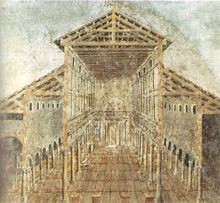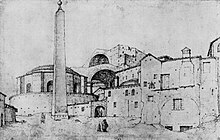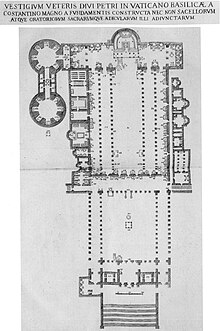
Back Köhnə Müqəddəs Pyotr bazilikası Azerbaijani Antiga basílica de Sant Pere Catalan Konstantins basilika Danish Παλαιά Βασιλική του Αγίου Πέτρου Greek Antikva baziliko Sankta Petro Esperanto Antigua basílica de San Pedro Spanish کلیسای قدیمی سنت پیتر Persian Konstantinuksen basilika Finnish Antique basilique vaticane French Régi római Szent Péter-bazilika Hungarian
| St. Peter's Basilica | |
|---|---|
Basilica Sancti Petri (Latin) | |
 19th-century drawing of St. Peter's Basilica as it is thought to have looked around 1450. The Vatican obelisk is on the left, still standing on the spot where it was erected on the orders of the Emperor Caligula in 37 AD. | |
 | |
| 41°54′8″N 12°27′12″E / 41.90222°N 12.45333°E | |
| Location | Rome |
| Country | Papal States |
| Denomination | Catholic Church |
| History | |
| Status | Major basilica |
| Consecrated | c. 360[citation needed] |
| Architecture | |
| Style | Early Christian |
| Groundbreaking | Between 326 and 333 |
| Completed | c. 360 |
| Demolished | c. 1505 |
| Administration | |
| Diocese | Diocese of Rome |

Old St. Peter's Basilica was the church buildings that stood, from the 4th to 16th centuries, where St. Peter's Basilica stands today in Vatican City. Construction of the basilica, built over the historical site of the Circus of Nero, began during the reign of Roman Emperor Constantine I. The name "old St. Peter's Basilica" has been used since the construction of the current basilica to distinguish the two buildings.[1]




- ^ Boorsch, Suzanne (Winter 1982–1983). "The Building of the Vatican: The Papacy and Architecture". The Metropolitan Museum of Art Bulletin. 40 (3): 4–8.
- ^ Reardon, 2004. p. 274